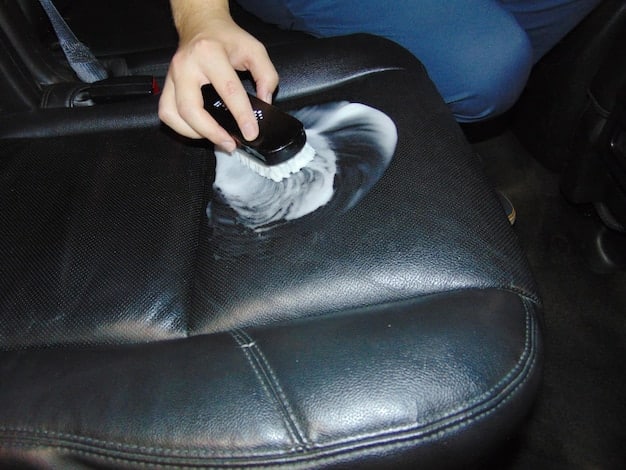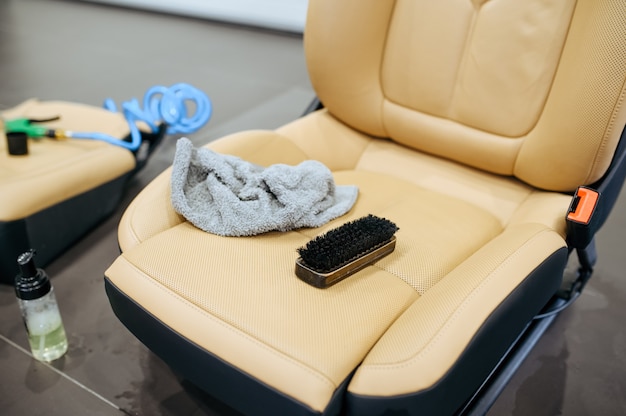The Definitive Guide to Cleaning & Protecting Your Car’s Leather Seats

The Ultimate Guide to Cleaning and Protecting Your Car’s Leather Seats provides step-by-step instructions on how to clean, condition, and protect your car’s leather seats, extending their lifespan and maintaining their appearance for years to come.
Leather seats add a touch of luxury to any vehicle, but they require regular care to stay in good condition. This The Ultimate Guide to Cleaning and Protecting Your Car’s Leather Seats will walk you through the process of cleaning, conditioning, and protecting your leather to keep it looking and feeling its best.
Understanding Leather Car Seats
Leather car seats aren’t just a luxury; they’re an investment in your vehicle’s comfort and aesthetics. However, understanding the type of leather in your car is crucial for proper care. Different types of leather require specific cleaning and conditioning methods to avoid damage and maintain their integrity.
Types of Leather Used in Car Seats
Automotive leather comes in various forms, each with its unique properties and care requirements. Knowing which type you have will help you choose the right cleaning and conditioning products.
- Full-Grain Leather: This is the highest quality leather, retaining the natural grain and markings of the hide. It’s durable and develops a patina over time, but it requires gentle cleaning and conditioning.
- Top-Grain Leather: A step down from full-grain, top-grain leather has had the outermost layer sanded to remove imperfections. It’s more uniform in appearance but still requires quality care to prevent cracking.
- Corrected-Grain Leather: This leather undergoes significant processing to create a uniform look and feel. It’s often embossed or dyed, and while it’s more resistant to stains, it still benefits from regular cleaning and conditioning.
- Leatherette/Synthetic Leather: While not true leather, these materials mimic the look and feel of leather and are more resistant to wear and tear. They require specific cleaning solutions designed for synthetic materials.
Regardless of the type of leather, regular maintenance is critical. Ignoring spills, dirt, and sunlight can lead to premature aging, cracking, and fading.
Essential Cleaning Supplies for Leather
Before you begin, gather the necessary supplies. Using the right tools and products will ensure effective cleaning and prevent damage to your leather seats. The key is to use products specifically designed for automotive leather to avoid harsh chemicals that can dry out or discolor the material.

Essential cleaning supplies include a dedicated leather cleaner, a leather conditioner, two clean and soft microfiber cloths, a soft-bristled brush (horsehair is ideal), a vacuum cleaner with a brush attachment, and a bucket of warm water.
Choosing the Right Leather Cleaner
Selecting the right leather cleaner is paramount. Look for pH-balanced products specifically formulated for automotive leather. Avoid harsh chemicals like bleach, ammonia, or solvents, which can strip the leather of its natural oils and cause damage.
Test the cleaner in an inconspicuous area first to ensure it doesn’t cause discoloration or damage. Apply a small amount to a hidden section of the seat and wait a few minutes. If there’s no adverse reaction, you can proceed with cleaning the rest of the seats.
Having the correct cleaning products and tools will set you up for success. Ensuring that your leather cleaning regime is catered correctly to prevent against future damage.
Step-by-Step: Cleaning Leather Car Seats
Cleaning your leather car seats involves a straightforward process that, when done correctly, will leave them looking and feeling like new. Begin with a thorough vacuuming to remove loose dirt and debris, followed by gentle cleaning and careful drying.
To start, vacuum the seats thoroughly using a soft brush attachment to remove loose dirt, crumbs, and debris. Pay special attention to seams and crevices where dirt tends to accumulate.
Applying the Leather Cleaner
Spray a small amount of leather cleaner onto a clean microfiber cloth. Gently wipe down the seats, working in small sections. Avoid spraying the cleaner directly onto the leather, as this can lead to oversaturation and potential damage. Use the soft-bristled brush to agitate any stubborn stains or dirt gently.
Wiping and Drying
Use a second clean, damp microfiber cloth to wipe away any remaining cleaner and dirt. Ensure you remove all traces of the cleaning product to prevent residue buildup. Allow the seats to air dry completely. Avoid using a heat source, like a hairdryer, as this can cause the leather to crack.
By following these steps carefully, you’ll effectively clean your leather car seats, preparing them for conditioning.
Conditioning Leather Car Seats
After cleaning, conditioning is essential to replenish the natural oils in the leather, keeping it supple and preventing it from drying out and cracking. Leather conditioners also add a layer of protection against UV rays and future stains. Choose a high-quality leather conditioner specifically designed for automotive use.
Choose a conditioner that is of high quality. This will promote its overall efficacy when applied via routine application.
Applying Leather Conditioner
Apply a small amount of leather conditioner to a clean microfiber cloth. Gently massage the conditioner into the leather in a circular motion, ensuring even coverage. Allow the conditioner to penetrate the leather for at least 10-15 minutes.
Buffing and Drying
Use a clean, dry microfiber cloth to buff the leather, removing any excess conditioner. This will help to prevent the leather from feeling sticky or greasy. Allow the seats to air dry completely. Avoid using the car until the conditioner has fully absorbed.
- Proper Ventilation: Ensure the car is well-ventilated during the conditioning process to allow the product to dry properly.
- Even Application: Apply the conditioner evenly to prevent dark spots or discoloration.
- Regular Conditioning: Aim to condition your leather seats every 3-6 months to maintain their condition.
Regular conditioning is key to maintaining the softness and flexibility of your leather seats, keeping them looking their best for years to come.
Protecting Leather Car Seats
Protecting your leather car seats goes beyond cleaning and conditioning. It involves taking steps to prevent damage from sunlight, spills, and everyday wear and tear. One of the best ways to protect your leather seats is to use a UV protectant product.
UV rays can cause leather to fade and crack over time. Applying a UV protectant will help to block these harmful rays and keep your seats looking newer for longer.

Using UV Protectants
Apply the UV protectant according to the manufacturer’s instructions. Generally, this involves spraying the product onto a clean microfiber cloth and wiping down the seats. Reapply the protectant every few months, especially during the sunnier months.
In addition to UV protection, consider using seat covers to protect your leather from spills, dirt, and wear and tear. Seat covers are particularly useful if you have children or pets that frequently ride in your car.
Parking in the shade or using a sunshade can significantly reduce the amount of UV exposure your leather seats receive. These simple steps can help prevent fading and cracking, extending the life of your leather.
With the right protections in place you can look forward to your leather interior staying pristine for years to come. Avoiding issues such as sun induced fading and unnecessary stains.
Routine Maintenance and Care Tips
Maintaining leather car seats requires a consistent approach and attention to detail. Regular cleaning and conditioning, combined with protective measures, will keep your leather looking its best and prevent premature aging.
Regularly vacuum your leather seats to remove loose dirt and debris. This will prevent dirt from grinding into the leather and causing damage over time. Use a soft brush attachment to get into seams and crevices.
Addressing Spills and Stains Immediately
The longer a spill sits on leather, the harder it is to remove. Blot spills immediately with a clean, dry cloth. Avoid rubbing, as this can spread the stain. For stubborn stains, use a leather cleaner specifically designed for stain removal.
Have a professional detail your car’s interior periodically. Professional detailers have the knowledge and equipment to thoroughly clean and condition your leather seats, addressing any issues you may have missed.
- Gentle Cleaning: Use pH-balanced leather cleaners to avoid damaging the leather.
- Regular Conditioning: Condition your seats every 3-6 months to keep them supple.
- UV Protection: Apply UV protectants to prevent fading and cracking.
By incorporating these routine maintenance tips into your car care routine, you can ensure that your leather seats remain in excellent condition for years to come.
| Key Point | Brief Description |
|---|---|
| 🧼 Cleaning Leather | Use pH-balanced cleaners and microfiber cloths to gently clean leather seats. |
| 🧴 Conditioning Leather | Apply conditioner every 3-6 months to keep leather soft and prevent cracking. |
| ☀️ UV Protection | Use UV protectants and sunshades to prevent fading and damage from sunlight. |
| 🚗 Routine Maintenance | Regularly vacuum seats and address spills promptly to maintain leather quality. |
Frequently Asked Questions
▼
You should aim to clean your leather car seats every 1-3 months, depending on usage and exposure to dirt. If you frequently drive with the windows down or transport pets, more frequent cleaning may be necessary.
▼
No, you should not use household cleaners on leather car seats. Harsh chemicals like bleach, ammonia, or solvents can damage or discolor the leather. Always use pH-balanced cleaners specifically designed for automotive leather.
▼
For stubborn stains, use a leather cleaner specifically designed for stain removal. Apply the cleaner to a clean microfiber cloth and gently blot the stain. Avoid rubbing, as this can spread the stain. If the stain persists, consult a professional detailer.
▼
Yes, conditioning leather car seats is essential. Conditioning replenishes the natural oils in the leather, preventing it from drying out and cracking. Regular conditioning keeps the leather supple and prolongs its lifespan.
▼
To protect your leather car seats from sun damage, use UV protectants, park in the shade, and use a sunshade. UV protectants help block harmful UV rays, while parking in the shade reduces direct sunlight exposure. A sunshade can also help to minimize heat buildup inside the car.
Conclusion
In conclusion, maintaining your car’s leather seats through regular cleaning, conditioning, and protection ensures their longevity and preserves the luxurious feel of your vehicle’s interior. By following these guidelines and using the right products, you can keep your leather seats looking their best for years to come.





